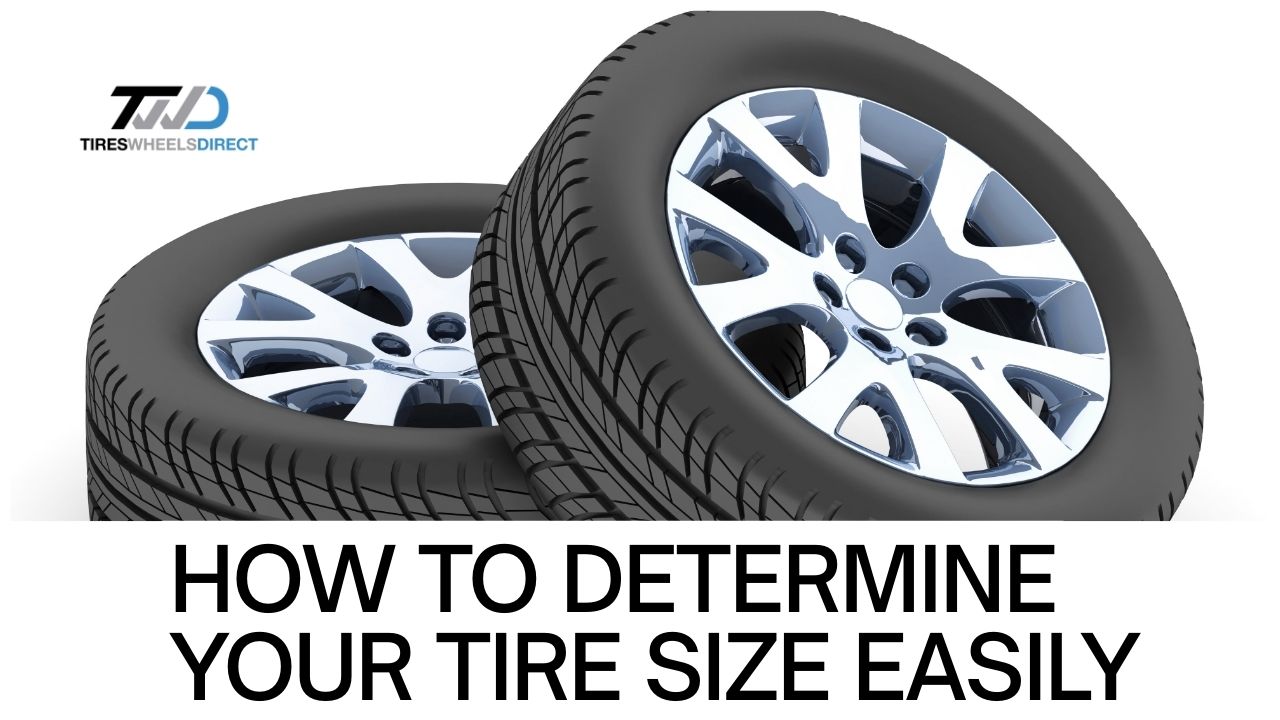How to Figure Tire Size: An Ultimate Guide

Trying to determine the correct tire size can be confusing at first. But don’t worry, we’re here to make it super simple. At Tires Wheels Direct, we help car owners understand tire sizing every day. This guide walks you through everything you need to know.
Are you shopping for new tires or wheels? Then understanding tire sizes is crucial for your safety. Additionally, getting the right fit saves you money and headaches in the long run. So let’s dive into how to read tire size like a pro.
Basic Tire and Wheel Terminology
Understanding Tire Size Components
Every tire has three main parts in its size code. These include section width, aspect ratio, and wheel diameter. Also, each part tells you something different about your tire.
Section width shows how wide your tire is. Meanwhile, aspect ratio affects your sidewall height. Finally, wheel diameter determines what rim size you need.
Overall Tire Diameter Explained
Overall, tire diameter matters more than most people think. This measurement affects your speedometer accuracy directly. Plus, it impacts ground clearance and fender space, too.
We use this number to check fitment issues. It also helps us spot potential rubbing problems early.
Wheel Width and Backspacing Basics
Wheel width controls how your tire sits on the rim. Wider wheels give you a different look and performance. But they also change your backspacing measurements.
Backspacing affects where your wheel sits in the fender well. Too much or too little causes clearance problems.
Offset and Centerline Fundamentals
Offset tells you where the mounting surface sits on your wheel. This measurement uses the centerline as a reference point. So a positive offset means the mounting pad sits toward the outside.
The centerline splits your wheel width exactly in half. We use this line to calculate both offset and backspace.
How Tire Size is Written and Interpreted
Breaking Down a Tire Size Code
Let’s look at a common tire size like 225/45R17. Each number and letter means something specific. First, 225 shows the section width in millimeters.
Next, 45 represents the aspect ratio as a percentage. Then R means radial construction. Finally, 17 indicates the wheel diameter in inches.
Aspect Ratio Impact on Sidewall Height
The aspect ratio directly controls your sidewall height. A lower number gives you a shorter sidewall. Meanwhile, higher numbers create taller sidewalls.
For example, a 45 aspect ratio means the sidewall is 45% of the section width. So with a 225mm section width, your sidewall is about 101mm tall.
Cross-Section Width Measurements
Cross-section width isn’t the same as mounted tire width. The tire actually measures slightly differently when mounted. This happens because the rim width affects the final shape.
We always check both measurements when fitting new tires. This prevents surprises during installation.
How to Use Our Overall Tire Diameter Calculator?
Required Calculator Inputs
Our overall tire diameter calculator needs three simple inputs. You’ll enter the aspect ratio, cross-section width, and wheel diameter. Then our tool does all the math for you instantly.
These numbers come straight from your tire sidewall. So you don’t need any special measuring tools.
Finding Your Tire Values
Reading your tire sidewall is easier than you think. Look for the size code printed on the side. It’s usually pretty big and easy to spot.
If you’re replacing old tires, check the manufacturer specs too. Sometimes the sidewall gets worn and is hard to read.
How the Calculator Works
Our calculator uses your aspect ratio and cross-section width first. It figures out your sidewall height in millimeters. Then it converts that to inches automatically.
Next, it adds twice the sidewall height to your wheel diameter. This gives you the complete overall tire diameter in inches.
Common Calculator Use Cases
Most people use our calculator for these reasons:
- Checking speedometer accuracy after tire changes
- Making sure new tires won’t rub anywhere
- Finding compatible replacement sizes
- Comparing different tire options side by side
Tire Size Comparison Chart
Understanding Size Differences
A tire size comparison chart shows you how different sizes stack up. This helps you see which sizes are close to your original. Also, it reveals which ones might cause problems.
We recommend staying within 3% of your original overall diameter. Going beyond this range affects your speedometer readings too much.
Popular Size Substitutions
Some tire sizes work as substitutes for others. For example, 225/45R17 and 215/50R17 have similar overall diameters. But they give you different performance characteristics.
The tire size chart makes these comparisons super easy. You can spot good alternatives at a glance.
How to Use Our Offset to Backspace Calculator?
Converting Offset to Backspace
Our Offset to Backspace Calculator takes your wheel specs and does the conversion. You just enter your wheel width in inches. Then add your offset in millimeters.
The tool instantly shows you the backspace measurement in inches. This helps when you’re shopping for wheels with specific backspace requirements.
How Offset Affects Mounting Position
Offset moves the mounting pad relative to the rim centerline. More positive offset pushes the mounting surface toward the outside. Meanwhile, a negative offset moves it toward the inside.
This directly changes where your wheel sits in the fender well. So it’s super important for clearance issues.
Measuring Existing Wheels
You can measure the offset on wheels you already own. Look for markings on the back of the wheel. They usually show the offset in millimeters.
If there are no markings, you’ll need to measure manually. But our calculator makes the conversion easy either way.
How to Use Backspace to Offset Calculator?
Converting Backspace to Offset
Sometimes you know the backspace but need the offset. Our Backspace to Offset Calculator handles this conversion perfectly. Just enter your wheel width and backspace measurements.
The tool converts everything to millimeters automatically. Then it shows you the offset value you need.
Measuring Backspace Accurately
Backspace measures from the mounting surface to the inner lip. You’ll need a straight edge and ruler for accuracy. Place the straight edge across the back of the wheel.
Then measure from the mounting surface to where it touches the inner lip. This gives you the backspace in inches.
What Negative Offset Means for Fitment
Definition and Visual Effects
Negative offset means the mounting flange sits past the rim centerline. This pushes your wheels further outboard from the car. So your wheels stick out more from the fenders.
This creates a wider stance and a more aggressive look. But it also affects handling and clearance.
When Negative Offset Works Well
Some builds benefit from negative offset wheels. These include:
- Custom trucks with wide fenders
- Show cars want an aggressive stance
- Off-road vehicles need a wider track width
- Classic cars with deep-dish wheel styles
Risks and Solutions
Negative offset can cause several problems. You might get fender rubbing or increased wear on wheel bearings. Plus, your scrub radius changes dramatically.
Solutions include fender rolling, spacers, or suspension adjustments. But always check the clearance carefully first.
What Positive Offset Means for Fitment
Definition and Practical Benefits
Positive offset moves the mounting surface toward the outside of the rim. This tucks your wheels further under the fenders. Most factory wheels use positive offset.
This setup usually reduces scrub radius and improves handling. It also provides better clearance for brakes and suspension parts.
Ideal Applications
Positive offset works great for:
- Stock replacement wheels
- Daily driver vehicles
- Cars with limited fender clearance
- Performance builds prioritizing handling
Potential Issues
Too much positive offset can cause inner clearance problems. Your wheels might hit suspension components or brake lines. Always check the inner clearance when going with a higher positive offset.
What Zero Offset Means for Fitment
Balanced Wheel Placement
Zero offset puts the mounting pad exactly at the rim centerline. This creates a balanced wheel placement with neutral characteristics. Neither inboard nor outboard bias affects the setup.
Many custom and classic applications use zero offset. It provides a good middle ground for most builds.
When Zero Offset Makes Sense
Zero offset works well for vintage car restorations. It also suits custom builds where you want neutral handling characteristics. Plus, it simplifies calculations for wheel spacers.
Conclusion
Learning to figure tire size isn’t as hard as it seems. You just need to understand the basic components and measurements. Plus, our free calculators make all the math super easy.
Remember to check your tire size explained markings on the sidewall first. Then use our overall-tire-diameter-calculator for fitment verification. Also, don’t forget to convert between offset and backspace as needed.
Ready to find your perfect tire and wheel combo? Use our tire size chart and calculators on Tires Wheels Direct today. We’re here to help you get the right fit every time.
Need extra help with how to read tire size or fitment questions? Contact our team at Tires Wheels Direct anytime. We love helping customers find their ideal setup.

